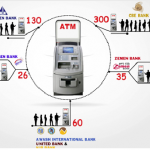 - Understanding the perceived liquidity crunch
- Understanding the perceived liquidity crunch
Abel Ketema (name altered to protect identity) is having it rough these past few months.
Financially, he is at his worst in the little over four years he has been in business. As he prefers to put it, business is too bad for him and his small company that specializes in import and installation of air ventilation system and related materials. A mechanical engineer by training, Abel broke out to lead his small practice about four years ago, which have seen nothing but a steady progress up until the beginning of this year. So far Abel have taken contracts from both government and private projects for some of which he did not receive payments. To make matters worse, this last month came with a complication of its own where he faced a danger of going to jail regarding a post-dated check he issued earlier on a bank account with insufficient balance. Apparently, writing post-dated checks on account having insufficient balance expecting some sort of future payment is a practice that has become common among the business community. Although issuing a blank check is a crime that is punishable by law, a number of transactions are conducted and payments are made on the basis of future receivables. With the exception of few, such transactions are settled before the matter escalates further.
Abel too is used to this practice; well until one of his checks nearly landed him in prison last month. “When I wrote the check, I had at least two payments scheduled in-time to settle my debt,” he remembers. He said, he had no doubt that he will be able to replenish his account by the time the check matures. It did not happen. In fact, Abel says that currently he is forced to cease operations as he did not have sufficient working capital at his disposal. “I do not know what is going on in the market, but there seems to be less and less of transactions concluded these days; and even when transacting, there seems to be a problem affecting payments”.
Abel’s story sums up the general mood among small and medium businesses around town, recently. Especially the trade and services sector looks to be at their lowest. And the one explanation most of them share is the difficulty of collecting their receivables. If it is not the payments, access to bank loans is another matter on the agenda of businessmen at the moment. Indeed, it can be argued that loan given to the private sector has never been at a satisfactory level during the past two or three years. The concern of crowding out the private sector has been in forum even for international institutions such as the the International Monetary Fund (IMF) and the World Bank (WB), during this time. What makes this different is that if it persists impact on the over all economic activity and the GDP might be inevitable, business people contend. However, it is not only about the private sector or those in the trade and services industry. Bank loans and critical foreign exchange supply is also a headache for those in the government’s priority areas. A consortium of 36 metal and engineering companies led by the Metals and Engineering Corporation (MeTEC) and including major car assembly lines in Ethiopia voiced their concern recently to the House of Peoples’ Representatives. Based on the result of a study that they commissioned, the group told parliamentarians that working capital loan and persistent letter of credit problem is stifling the sector. However, the basic question here would be if it is enough to say that liquidity is in short supply at the moment. What is more interesting to see is the emergence of completely opposing sets of evidence regarding the existence of liquidity crunch in the market.
As far as the policy lending institution (Development Bank of Ethiopia) is concerned business is as usual. In a phone interview with The Reporter, Esayas Bahre, president of the bank, said that the bank has faced no problem of approving and disbursing loans. If there is the perceived liquidity shortage, the president is sure that his bank is not feeling any bit of it. Nevertheless, private bankers seems to have another story to tell. According to a banker who does not want to be named, the cumulative effect of the National Bank of Ethiopia (NBE-bill) allotment and fierce competition for deposit they face from the state-owned banking giant Commercial Bank of Ethiopia (CBE) is wearing them out. The rate at which deposit is collected in the face of the new deposit mobilizing strategy of CBE such as the new housing scheme, and the rate at which their (private bank’s) deposit base is been eroded by NBE-bills calls for real alarm, according to the the banker. On the other hand, some government institutions as well did not refrain from voicing their concern over inadequate budget alloted and disbursement this year.
In this regard, in their recent appearance to the parliament Minister of Transport, Workineh Gebeyehu, and general manager of Ethiopian Road Authority (ERA), Zaid Woldegebriel, both emphasized on the issue of budget. They told parliamentarians that the road sector is not getting sufficient budget from the treasury. ERA is known to be one government agency where spending via its projects have greater chance to impact the private sector. Responding to questions from MPs about road maintenance, Zaid emphasized on shortage of budget for the road sector. To this end, the authority is said to have accumulated arrears of payment obligation to contractors, which it could not meet in time. For instance, Ethiopian Road Corporation a recent brake-out from ERA to independently operate as a construction company is said to have close to 1 billion birr payment claim on the authority. Traditionally, road construction tops the Ethiopian budget table. And commentators argue there is no better evidence for liquidity shortage than ERA feeling the pinch.
To the contrary, Haji Ibsa, Public Relation Directorate Director at Ministry of Finance and Economic Development (MoFED), insists that the national treasury do not have cash shortage. He says that, during the first half of this year the tax authority has collected some 63 billion birr and that the government can not possibly face any liquidity issues at this time. “We have disbursed the alloted budget to the agencies and regional governments according to their payment schedules,” Haji told The Reporter. Although this schedule is not uniform across all agencies, it can be assumed that halfway through the budget year, around 75 billion birr of the 150 billion approved for this fiscal year has been disbursed to the relevant institutions, he explains further. Haji categorically denounces any suggestion of possible liquidity problem. “Especially this year we can not face any shortage of money since we are on the move to program budget format; every thing is planed ahead,” he argued. Still economists like Costentinos Behre (Ph.D.) sees things much differently. In fact, they contend that the crunch is all too clear for every one to see. There is no question liquidity is in short supply, according to Costentinos. “The NBE-bill purchase which amounts to redirecting significant amount of the liquidity to DBE is finally taking its tall on the private sector,” he explains. “And this drain on the banks loanable resource will impact the level of credit available to the private banks.” From macroeconomic point of view, redirecting does not mean draining liquidity out of the system as it will be reinvested on the government projects, Costentinos argues. But, the spending of the government itself is what one should look at, he continues to elaborate, if the spending is focused on some of mega projects, the chances for this money to enter the circulation and affect the local market is small. Government spending affects the level of aggregate demand when large portion of this spending is kept on goods and services which are sold in the local market, he explained to The Reporter. Costentinos is of the view that expenditure on mega projects pay big portion of their money to foreign companies and investment goods, with the exception of labor and cement products procured from the domestic market. This by itself amounts to limiting the level of money in the system, he argues.
Nevertheless, quite a number of pundits and businesspeople point their finger on the fiscal authority to be implementing some sort of a conscious restraint on its spending or at very least lagging it to achieve a certain goal. Assuming this argument carries merit, the question remains why the fiscal authority would do it. Haji says inflation is on MoFED’s agenda these days. Although he did not admit to spending restraint, Haji did say that disbursement to respective agencies would follow a strict payment schedule. “Now we are implementing program budget system which require strict earmarking of the budget with a specific project,” he explains. In the past (line budget system), agencies had the mandate to claim the total budget disbursement alloted to them, rearrange expenditure or shift from project-to-project. “Now agencies had to think long and hard before filling out their budget request. Because once earmarked for a certain project, the agency cannot shift the budget from one project to the other; they either use it for the purpose they say they would or return it,” Haji stressed. According to the public relations man, this is what program budgeting is all about. Nevertheless, he also underscored that MoFED would not entertain any question regarding supplementary budget. “Those days are gone where agencies would come knocking when ever a need for extra budget emerges,” he argues. He says we can not do that if we want to keep inflation close to a single digit. Last month, headline inflation hovers around 8 percent, and Haji underlined that the fiscal authority is not about to let this slip through their figures.
In this regard, commentators argue that the implementation of the new program budgeting and discontinuing the traditional practice of budget supplements could amount to a financial shock for government agencies, which could turn out to be a hiccup to the market.
Perhaps, a point worth noting here is if the fiscal authority supposed to be concerned with inflation to that level. Pundits approached by The Reporter seems have divergent view on the matter. Some bash MoFED for announcing to have been working to attain a single digit inflation, something that is not in the job description of the organization. Hitting an inflation target given to it by the political leadership is in fact something central banks live for. The treasury also has the duty of keeping a sound fiscal sector and realizing output growth. Traditionally, the two might be so consumed in realization of their own goals that they work so hard to try to balance the effect of the policies of each other, pundits explain. This usually helps to have a healthy price level (inflation) and economic growth, they elaborate further. Still, there are also economist who argue in favor of coordination. Working to counteract each other is wasteful activity; rather coordinating could deliver better outcome both in terms price or output, these economists explain. Nevertheless, proponents of this argument underscore that independence of the two institutions and the goals they try to maximize are necessary conditions to have a thriving coordination between the two. In that, the treasury and central bank work together to fix target of inflation and growth while both pooling their end of the rope to make the plan come true. “In view of this, it is strange that MoFED openly announces that it is working to maximize an inflation target where it should have been doing that to its traditional mandate,” the pundit argues.
For now Abel has been saved by the bell where he was able to settle his payment without seeing the inside of the prison cell. But, his financial condition are far from being better. And by the looks of things, there is no sign of immediate recovery for him or the people around him. “But, where did the money go?” he ponders.
By Asrat Seyoum and Berhanu Fekade
WRITTEN BY ASRAT SEYOUM , Reporter

















![23-year-old Ethiopian surprises his mother with a cheque that pays off her mortgage [May 2013] 23-year-old Ethiopian surprises his mother with a cheque that pays off her mortgage [May 2013]](https://www.ethiopianopinion.com/wp-content/plugins/top-10/timthumb/timthumb.php?src=http%3A%2F%2Fwww.ethiopianopinion.com%2Fwp-content%2Fuploads%2F2014%2F03%2Fdearmother-150x150.jpg&w=&h=&zc=1&q=75)










Join Conversations